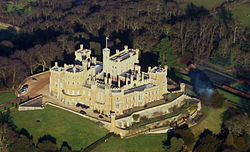Our website is made possible by displaying online advertisements to our visitors.
Please consider supporting us by disabling your ad blocker.
Belvoir Castle
| Belvoir Castle | |
|---|---|
 Belvoir Castle | |
| General information | |
| Architectural style | Gothic Revival |
| Location | Northeast Leicestershire |
| Country | England |
| Coordinates | 52°53′40.2″N 0°46′57.22″W / 52.894500°N 0.7825611°W |
| Elevation | 138 metres (453 ft) |
| Groundbreaking | 1067 |
| Renovated | 1801–1832 |
| Owner | David Manners, 11th Duke of Rutland |
| Design and construction | |
| Architect(s) | James Wyatt |
| Designations | |
Listed Building – Grade I | |
| Designated | 14 July 1953 |
| Reference no. | 1360870 |
| Website | |
| https://www.belvoircastle.com/ | |
Belvoir Castle (/ˈbiːvər/ ⓘ BEE-vər)[1] is a faux historic castle and stately home in Leicestershire, England, situated 6 mi (10 km) west of the town of Grantham and 10 mi (16 km) northeast of Melton Mowbray. A castle was first built on the site immediately after the Norman Conquest of 1066 and has since been rebuilt at least three times. The final building is a grade I listed mock castle,[2] dating from the early 19th century. It is the seat of David Manners, 11th Duke of Rutland (the tiny county of Rutland lies 16 mi (26 km) south[3] of Belvoir Castle), whose direct male ancestor inherited it in 1508. The traditional burial place of the Manners family was in the parish church of St Mary the Virgin, Bottesford, situated 3 mi (5 km) to the north of the Castle, but since 1825 they have been buried in the ducal mausoleum built next to the Castle in that year, to which their ancient monuments were moved. It remains the private property of the Duke of Rutland but is open to the general public.
The castle is situated at the extreme northern corner of the county of Leicestershire and is sandwiched between Lincolnshire to the east and Nottinghamshire to the west, and overlooks the Vale of Belvoir to the northwest[4] on the Nottinghamshire border. It is surrounded by the villages of Redmile, Woolsthorpe, Knipton, Harston, Harlaxton, Croxton Kerrial and Bottesford. The antiquarian John Leland (d.1552) stated: "the Castle stands on the very nape of a high hill, steep up each way, partly by nature, partly by the working of men's hands".[5]
The 15,000 acre (6,000 hectare)[6] Belvoir estate, situated in the heart of England's fox-hunting terrain is the headquarters of the Belvoir Hunt ("the Duke of Rutland's Hounds"[7]), established in 1750 and now kennelled 0.6 mi (1 km) southeast of the Castle.
- ^ "Belvoir Castle". Collins Dictionary. n.d. Archived from the original on 6 May 2018. Retrieved 25 September 2014.
- ^ Historic England. "Belvoir Castle (1360870)". National Heritage List for England. Retrieved 17 July 2007.
- ^ Based on position of Oakham, county town of Rutland
- ^ grid reference SK820337
- ^ Quoted in Cantor 1977–1978 p. 35.
- ^ "The Manners Arms". The Manners Arms. Archived from the original on 7 May 2021. Retrieved 10 August 2013.
- ^ "The Belvoir Hunt - Home page". www.belvoir-hunt.co.uk. Archived from the original on 31 July 2021. Retrieved 20 January 2023.
Previous Page Next Page



